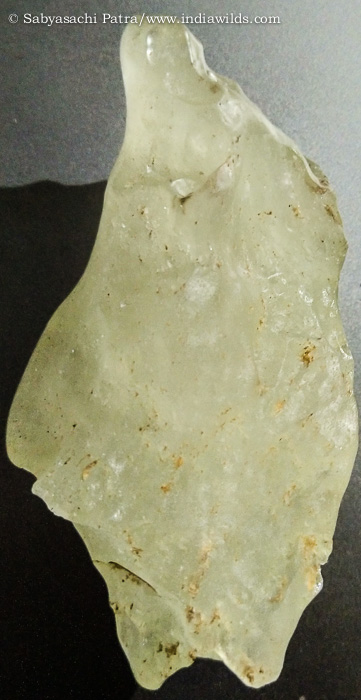Libyan Desert Glass formed by Meteorite hit
For a long time there has been difference of opinions about the origins of Libyan Desert Glass. This yellow translucent glassy looking rocks are found over several thousand square kilometers in Western Egypt and came to the notice of outside world as it was used to make a scarab found in King Tut’s pectoral. Scarabs were popular amulets and impression seals in Ancient Egypt. Many scarabs have survived the passage of time and through the inscriptions and typology, historians and archaeologists have derived lot of important information about that era.
Scientists have decided that Libyan Desert Glass was formed some 29 million years ago. Some believe this this yellow glass like rocks were created by the impact of a meteorite and some believe that it originated in an airburst, when asteroids explode and deposit energy in the earth’s atmosphere.
A recent paper in Geology (Overestimation of threat from 100 Mt–class airbursts? High-pressure evidence from zircon in Libyan Desert Glass, Cavosie et. al, May 2019) has solved this mystery. The lead author Dr. Aaron Cavosie from the Curtin’s School of Earth and Planetary Sciences said “It has been a topic of ongoing debate as to whether the glass formed during meteorite impact, or during an airburst, which happens when asteroids called Near Earth Objects explode and deposit energy in the Earth’s atmosphere…Both meteorite impacts and airbursts can cause melting, however, only meteorite impacts create shock waves that form high-pressure minerals, so finding evidence of former reidite confirms it was created as the result of a meteorite impact.”
High-temperature fusion occurs during meteorite impact as well as in airbust. However airbursts do not produce shocked minerals; airbursts generate overpressures at the level of thousands of pascals in the atmosphere, whereas crater-forming impacts generate shockwaves at the level of billions of pascals on the ground.
In the Libyan Desert Glass, the scientists found the presence of granular zircon grains that are comprised of neoblasts that preserve systematic crystallographic orientation relations that uniquely form during reversion from reidite, a 30 GPa high-pressure ZrSiO4 polymorph, back to zircon. Evidence of former reidite provides the first unequivocal substantiation that Libyan desert glass was generated during an event that produced high-pressure shock waves; these results thus preclude an origin of Libyan Desert Glass by airburst alone. Other glasses of disputed origin that contain zircon with evidence of former reidite, such as Australasian tektites, similarly were also likely made during crater-forming events.
- Endangered Wild Buffalo of Kaziranga - 4 July,2024
- Leopards: The Last Stand Trailer 2 - 1 July,2024
- GoPro Hero 12 Black - 6 September,2023





Leave a Reply